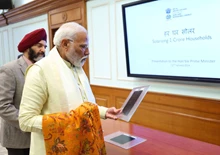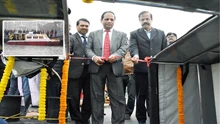
Bishweswar Tudu, Minister of State for Jal Shakti, stated in a written reply in the Rajya Sabha that the country's per capita water availability is declining as a result of the rise in population.
He continued in his response, "The average annual per capita water availability for the year 2031 has been assessed as 1367 cubic metres based on the study of 'Reassessment of Water Availability in India utilizing Space Inputs' (CWC, 2019)."
This could be an indication that the country is inching towards a water stress situation. A condition known as water stress is when there is less than 1700 cubic metres of water available annually per person.
Any location or nation's average yearly water availability is heavily influenced by hydro-meteorological and geological factors. However, the population of a country affects how much water is available per person.
According to Dynamic Ground Water Resource Assessment 2022, out of the country's total of 7089 assessment units, 1006 units in 16 States and UTs have been labelled as "over-exploited" because their annual ground water extraction exceeds their annual extractable ground water resource. A total of 260 units have been designated as 'Critical', 885 as 'Semi-critical', 4780 as 'Safe', and 158 as 'Saline'.
The minister in his reply said that since water is a state matter, each state government is largely responsible for taking action to increase, conserve, and manage water resources effectively, and the Central Government offers technical and financial support to the state governments through a variety of schemes and programmes to supplement their efforts.
He further mentioned that in order to manage groundwater sustainably in areas that have been identified as being water-stressed, the Atal Bhujal Yojana, a World Bank-supported Central Sector Scheme of the Indian government, is being implemented with an emphasis on community engagement and demand-side interventions.
A total of seven states in the country are implementing the programme. Haryana, Gujarat, Karnataka, Madhya Pradesh, Maharashtra, Rajasthan, and Uttar Pradesh are participating in the initiative and are actively monitoring and disseminating ground water data, water budgeting, and preparing Gram-Panchayat-wise water security plans and their implementation through convergence of ongoing schemes and IEC activities related to sustainable ground water management.
India being an agriculture-centric country, the government of India has been implementing the Pradhan Mantri Krishi Sinchayee Yojna (PMKSY) since 2015–16 to ensure the best possible use of water. In 2016–17, 99 ongoing major or medium irrigation projects were given a priority under the PMKSY-Accelerated Irrigation Benefit Programme (AIBP), and 50 of those projects have reportedly had their AIBP work finished. The government has also authorised the extension of PMKSY for the years 2021–22 to 2025–26, with a total outlay of Rs. 93,068.56 crore.
Further, from 2015–16 onwards, the Command Area Development and Water Management (CADWM) Program will fall under PMKSY – Har Khet Ko Pani. The primary goal of beginning CAD work is to increase the use of newly generated irrigation potential and increase agricultural productivity through Participatory Irrigation Management (PIM), the statement informed the Upper House.











